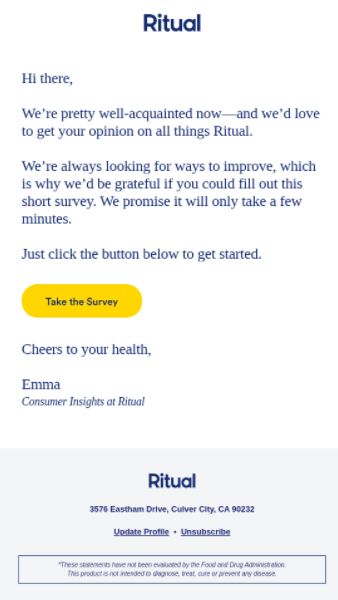Nothing can beat customer loyalty in business. Loyal customers will single-handedly spread the word out about you and your product and will get you high-quality conversions from among their friends and families.
You basically won’t need to worry about anything but serving your growing community of customers.
But to get that level of loyalty demands a lot of work. Loyal customers are more elusive than you think. A recent study shows that 3 out of 5 customers were willing to give up a former favorite brand in order to have a better service experience. It’s obvious that to convert a prospect into a loyal customer, you need to go a long way.
1. Get to know your customers
First and foremost, the question that every business owner in pursuit of loyal customers should ask themselves is “how well do I know my customers?” Is it just some hypothetical customer persona that we came up with overnight, or are we really connected with our customers?
To be connected with your customers means that you should know them inside out. You should know their problems and anxieties and how to help them get rid of them. All your business values, marketing messages, and customer service efforts should be aligned with how your customers could be transformed to the desired state be it increasing sales, having better social interactions or finding their life purpose.
To get to know your customers better, try to answer the following questions:
- What are the demographic and psychographic features of your target audience? Use surveys to get to understand your audience better. Or search through social media to get to know the people who are using similar products. Social listening tools such as Mention and survey tools such as SurveyAnyPlace are a great advantage here.
- What are your audience’s concerns and what do they desire the most? Talk frequently with your sales and support teams and figure out what concerns your customers the most and how you should address these with your content.
- What’s your customers’ journey like? Take time to determine when your customers start interacting with you in the first place and how this relationship develops. Create a customer journey map so that you’d know how to support your customers with your content throughout their journey with you. Most of the times, people rely on others’ reviews to decide if they can trust you. Online reputation management, especially regarding Google reviews, is an important issue. Jonas Sickler’s guide on removing bad (or fake) Google reviews is a great help here.
- Who are your competitors and what products are they offering? Do a rigorous competitive analysis to know how to beat your competitors. Study their product features and figure out the most favorite ones. You’ll know what features of your own products should be boldly mentioned in your content more frequently and what shouldn’t be. These ads spy tools could be a life-saver for competitive analysis.
- What topics and keywords are your competitors targeting and how can you outrank them? Competitive analysis tools such as Ahrefs, Buzzsumo, etc. would give you basically all the information you need about your competitors and how to outrank them. Find out what pieces perform well for them and try to produce content that outperforms them (e.g. by building more links, producing more comprehensive content, increasing web traffic to them to encourage more engagement etc.)
2. Respect your customers’ intelligence
People are marketing-savvy these days. This means that they see a lot of ads each day, receive a lot of emails, talk with sales representatives frequently, etc. You can’t just expect a poorly designed ad, or a carelessly written copy to do the magic for you anymore. It gets even worse when you try to win people over with deceptive ads and click-bait.
So let’s start by taking a look at what to avoid during the first steps in the customer journey. First up: misleading marketing campaigns.
Don’t: Mislead your audience
Mobile advertising
Some of the most repulsive deceptive ads and click-bait are happening in mobile advertising. Chatmost placed a dirt mark on its banner ad so that people would try to clean it and touch the ad.
Kaiwei Ni, a Chinese sneakers manufacturer, used the same tactic for getting people to tap its ads. This time they placed a strand of hair on the picture in order to trick people into touching the screen.

The results of these tactics were nothing other than people’s distrust. In a short time, these companies went viral as examples of companies using deceptive advertising. Lots of subreddits are talking about them and they got mentioned in big publications such as Adweek for their shady methods.
Email marketing
Some other dishonest marketing tactics are related to email marketing. Examples of these tactics include adding people to your lists without their consent, making it intentionally difficult to unsubscribe, and sending clickbait subject lines.
I’m subscribed to around 100 email newsletters, and there are a few that have earned my distrust over time. They generally use clickbait subject lines to get opens. Here are a few examples from my inbox:
- “Want my website?” (This person was a selling his website themes)
- “I told you not to do this” (I had no previous communication with them)
- “Your subscription is expiring” (What subscription?)
The latest revolutionary technique of these people is using “Re:” in their subject lines without ever starting a conversation with me.
- “Re: your invite”
- “[last chance] Re: your offer”
- “Re: Join . . . in London on October 19th – save your spot now!”
I get so frustrated when I see these emails in my inbox. Send me clickbait and I’ll doubt whatever claims you make — anytime, anywhere.
If you’re wondering what makes a clickbait title, here are some cases:
- Deceptive about who the email is from: “Did I leave my jacket at your place?” seems to be from a friend, but it’s not.
- Deceptive about previous email exchanges: the blatant “Re:” type
- Deceptive about the urgency of a message: “Urgent — Update your information.” You click on it just to find it’s a promotional email.
- Deceptive about an action taken by the subscriber: “Your Reservation Confirmation,” “About your order,” “Thanks for your order!”
According to CAN-SPAM act, each separate email that violates its requirements is subject to penalties of up to $41,484. So you might want to check out the act’s requirements before you send another email.
Take note that mobile advertising and email campaigns are not necessarily misleading campaigns. These are merely examples of how not to run your campaign.
Let’s jump to some tips on how to run your email marketing campaign correctly.
Do: Engage with your audience
How do you write catchy email subject lines for sales emails that are attention-grabbing and honest? These values will help you to engage and connect with your audience truthfully.
There are two things you need to do:
- Be relevant: Citing the article they’ve written, a person you both know, any new projects their company is working on, or a problem they’re facing (and how to solve it) will make your subject line more relevant. Subject lines like, “We both know [a person]” or “A word on your [name of the project],” “Could your sales team produce more leads? Here’s how,” or “How I lost your Sperry’s … and why you should meet with me” still rock.
- Use your industry’s hottest news: If a personality, product, number, or practice is trending in your industry, use it in your subject line. It will pique the receiver’s interest and get a click. Some examples are “Facebook dropped the ball — we picked it up,” “The new Amazon feature rocks but there’s a catch,” and “AI helping you get more leads”.
Your customers’ feedback is one of the most valuable assets you need to grow your business. Use customer feedback software to collect and manage your customers’ feedback. You can basically use their feedback in any phase of your business growth from product development to advertising.
3. Increase the purchase frequency of your customers
One of the greatest ways to improve customer loyalty is increasing the number of frictionless and pleasant transactions between you and your customers.
An HBR article explains that people have an inclination to buy from the businesses they have already bought frequently from.
It seems that our brain is biased towards the products or businesses that are more easily accessed or in other words mentally processed more fluently. And “processing fluency is itself the product of repeated experience, and it increases relentlessly with the number of times we have the experience.” In other words, as people experience your business more, it becomes more accessible and preferred for them.
Now, there are various ways to increase the purchasing frequency of your customers. Providing an easy and frictionless buying process, up-selling or cross-selling, giving special offers, coupons, trials, or tripwires are good examples.
Having a mobile-friendly website is very effective in increasing the purchase frequency of your visitors. More than half of the people searching for your services use their mobile devices and according to this guide on mobile-friendly design, only 9% of them will stay on your website or app if they couldn’t find what satisfies their needs right away. 61% of them won’t hesitate to move on to another website or app.
Having a mobile-friendly website is a necessity for increasing your sales.
4. Ask your customers for feedback
Probably the most important step if you want to turn prospects into loyal customers, is to ask for feedback. Customer feedback will help you define and improve your marketing strategy.
Consumers are high-demanding creatures, who will certainly have an opinion about how they were approached or want to be approached. If you set customer feedback surveys in place, you can ask specific questions in every step of the customer journey.
Make sure to ask the right customer feedback questions, and avoid survey fatigue. So don’t make your survey too long. You can, for example, ask 1 small pop-up question on exit intent.
You can also send out a customer satisfaction email. Such a campaign will not only help you to improve your marketing strategies, but also enable you to develop better products. Here are tips on how to motivate your audience to get the right feedback.

Conclusion
Although marketing automation tools have made marketing seem like a breeze for many people, converting your prospects into loyal customers is more difficult than you think.
Building a long-term relationship with your customers demands a good understanding of them and their needs, well-thought marketing and relationship management strategies that do not offend people’s intelligence, and frequent pleasant purchase experiences that will portray you as a trustworthy and reliable company.



